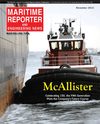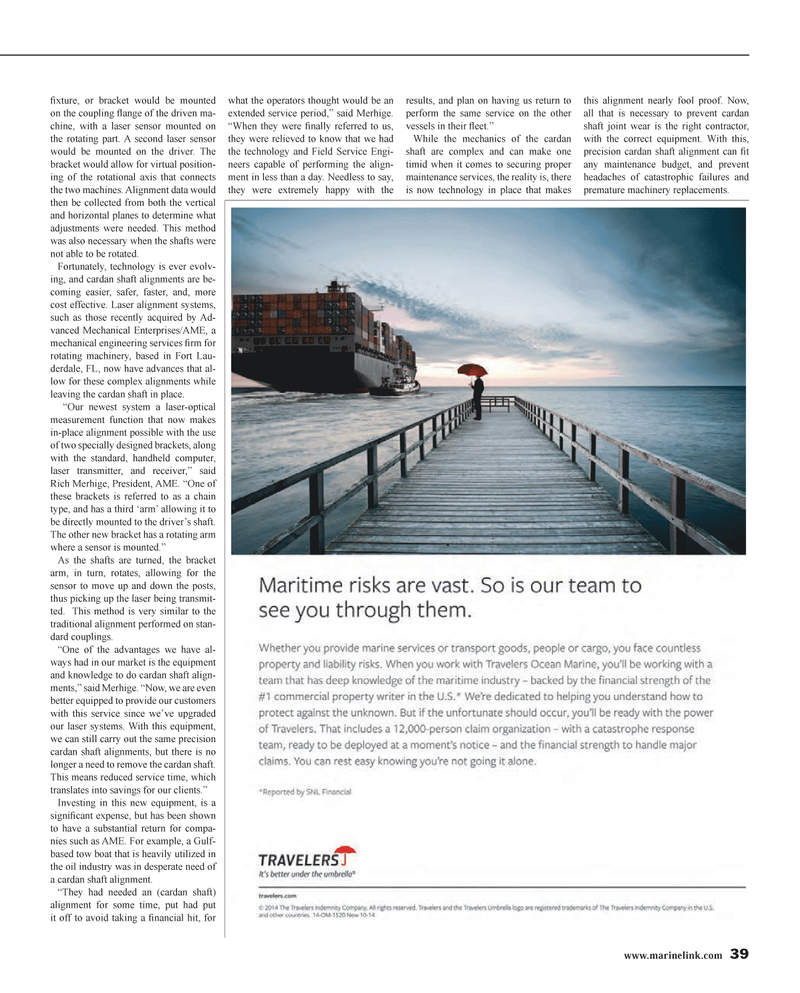
Page 39: of Maritime Reporter Magazine (November 2014)
Workboat Edition
Read this page in Pdf, Flash or Html5 edition of November 2014 Maritime Reporter Magazine
www.marinelink.com 39 ? xture, or bracket would be mounted on the coupling ? ange of the driven ma- chine, with a laser sensor mounted on the rotating part. A second laser sensor would be mounted on the driver. The bracket would allow for virtual position- ing of the rotational axis that connects the two machines. Alignment data would then be collected from both the vertical and horizontal planes to determine what adjustments were needed. This method was also necessary when the shafts were not able to be rotated.
Fortunately, technology is ever evolv- ing, and cardan shaft alignments are be- coming easier, safer, faster, and, more cost effective. Laser alignment systems, such as those recently acquired by Ad- vanced Mechanical Enterprises/AME, a mechanical engineering services ? rm for rotating machinery, based in Fort Lau- derdale, FL, now have advances that al- low for these complex alignments while leaving the cardan shaft in place. “Our newest system a laser-optical measurement function that now makes in-place alignment possible with the use of two specially designed brackets, along with the standard, handheld computer, laser transmitter, and receiver,” said
Rich Merhige, President, AME. “One of these brackets is referred to as a chain type, and has a third ‘arm’ allowing it to be directly mounted to the driver’s shaft.
The other new bracket has a rotating arm where a sensor is mounted.”
As the shafts are turned, the bracket arm, in turn, rotates, allowing for the sensor to move up and down the posts, thus picking up the laser being transmit- ted. This method is very similar to the traditional alignment performed on stan- dard couplings. “One of the advantages we have al- ways had in our market is the equipment and knowledge to do cardan shaft align- ments,” said Merhige. “Now, we are even better equipped to provide our customers with this service since we’ve upgraded our laser systems. With this equipment, we can still carry out the same precision cardan shaft alignments, but there is no longer a need to remove the cardan shaft.
This means reduced service time, which translates into savings for our clients.”
Investing in this new equipment, is a signi? cant expense, but has been shown to have a substantial return for compa- nies such as AME. For example, a Gulf- based tow boat that is heavily utilized in the oil industry was in desperate need of a cardan shaft alignment. “They had needed an (cardan shaft) alignment for some time, put had put it off to avoid taking a ? nancial hit, for what the operators thought would be an extended service period,” said Merhige. “When they were ? nally referred to us, they were relieved to know that we had the technology and Field Service Engi- neers capable of performing the align- ment in less than a day. Needless to say, they were extremely happy with the results, and plan on having us return to perform the same service on the other vessels in their ? eet.”
While the mechanics of the cardan shaft are complex and can make one timid when it comes to securing proper maintenance services, the reality is, there is now technology in place that makes this alignment nearly fool proof. Now, all that is necessary to prevent cardan shaft joint wear is the right contractor, with the correct equipment. With this, precision cardan shaft alignment can ? t any maintenance budget, and prevent headaches of catastrophic failures and premature machinery replacements.
MR #11 (34-41).indd 39 10/28/2014 10:33:30 AM

 38
38

 40
40
